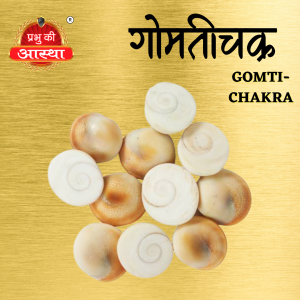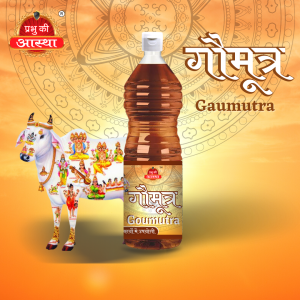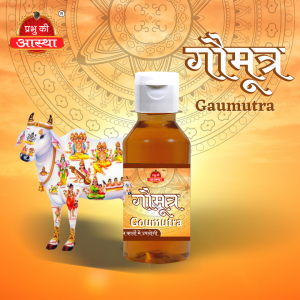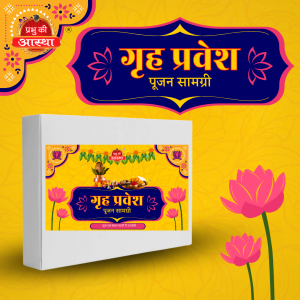PUJA ITEMS
-
 Read more
Read moreGomti Chakra is a rare natural shell stone found in the Gomti River in India. It is a sacred object that holds great significance in Hinduism and is used in various religious rituals and ceremonies.
The Gomti Chakra is believed to be a symbol of the goddess Lakshmi, the Hindu goddess of wealth, prosperity, and fortune. It is also associated with Lord Vishnu, the preserver of the universe, and is believed to have the power to bring good luck and ward off negative energies.
The Gomti Chakra is usually found in the form of small, round, disc-like stones with a spiral pattern on one side. They are considered to be very auspicious and are often used as talismans or amulets to attract good luck and prosperity.
In Hinduism, the Gomti Chakra is often used in puja rituals and is placed on the altar along with other sacred objects. It is also believed to have healing properties and can be placed in water and used for bathing or drinking to cure ailments.
In addition to its religious and spiritual significance, the Gomti Chakra is also believed to have scientific properties. It is said to have a unique energy that can influence the human body, mind, and soul positively.
Overall, the Gomti Chakra is an important symbol of spirituality and is revered by many Hindus around the world. It is a powerful tool for attracting good fortune, promoting health and well-being, and warding off negative energies.
-
 Read more
Read moreGopi Chandan is a type of clay that is considered sacred in Hinduism and is commonly used in puja ceremonies. It is believed to have numerous spiritual and therapeutic properties and is often used to make tilak or sacred markings on the forehead during worship. According to Hindu mythology, Gopi Chandan is said to have…
-
 Read more
Read moreGaumutra, also known as cow urine, is a substance that has been used for centuries in Ayurveda, an ancient system of medicine that originated in India. Cow urine is considered to be a sacred substance in Hinduism, and it is believed to have medicinal properties that can help treat various ailments. In Ayurveda, gaumutra is…
-
 Read more
Read moreGaumutra, also known as cow urine, is a substance that has been used for centuries in Ayurveda, an ancient system of medicine that originated in India. Cow urine is considered to be a sacred substance in Hinduism, and it is believed to have medicinal properties that can help treat various ailments.
In Ayurveda, gaumutra is believed to have antiviral, antimicrobial, and anti-inflammatory properties, making it a popular ingredient in many traditional Ayurvedic remedies. It is also believed to help improve digestion, boost immunity, and detoxify the body.
Cow urine is also used in many Hindu religious rituals, where it is considered to be a purifying substance that can ward off negative energies and evil spirits. It is often mixed with other sacred substances, such as turmeric and sandalwood paste, to create a paste that is used to anoint the deities during puja.
In recent years, there has been growing interest in the use of cow urine as an alternative medicine, with some proponents claiming that it can even help treat serious illnesses, such as cancer and HIV/AIDS. However, more research is needed to fully understand the potential health benefits of cow urine, and its use should always be done under the guidance of a qualified healthcare professional.
Overall, gaumutra or cow urine plays an important role in Hinduism and Ayurveda and is believed to have many medicinal and purifying properties. Its use is deeply rooted in tradition and is an important part of many religious and cultural practices in India.
-
 Read more
Read moreGaumutra, also known as cow urine, is a substance that has been used for centuries in Ayurveda, an ancient system of medicine that originated in India. Cow urine is considered to be a sacred substance in Hinduism, and it is believed to have medicinal properties that can help treat various ailments.
In Ayurveda, gaumutra is believed to have antiviral, antimicrobial, and anti-inflammatory properties, making it a popular ingredient in many traditional Ayurvedic remedies. It is also believed to help improve digestion, boost immunity, and detoxify the body.
Cow urine is also used in many Hindu religious rituals, where it is considered to be a purifying substance that can ward off negative energies and evil spirits. It is often mixed with other sacred substances, such as turmeric and sandalwood paste, to create a paste that is used to anoint the deities during puja.
In recent years, there has been growing interest in the use of cow urine as an alternative medicine, with some proponents claiming that it can even help treat serious illnesses, such as cancer and HIV/AIDS. However, more research is needed to fully understand the potential health benefits of cow urine, and its use should always be done under the guidance of a qualified healthcare professional.
Overall, gaumutra or cow urine plays an important role in Hinduism and Ayurveda and is believed to have many medicinal and purifying properties. Its use is deeply rooted in tradition and is an important part of many religious and cultural practices in India.
-
 Read more
Read moreGaumutra, also known as cow urine, is a substance that has been used for centuries in Ayurveda, an ancient system of medicine that originated in India. Cow urine is considered to be a sacred substance in Hinduism, and it is believed to have medicinal properties that can help treat various ailments.
In Ayurveda, gaumutra is believed to have antiviral, antimicrobial, and anti-inflammatory properties, making it a popular ingredient in many traditional Ayurvedic remedies. It is also believed to help improve digestion, boost immunity, and detoxify the body.
Cow urine is also used in many Hindu religious rituals, where it is considered to be a purifying substance that can ward off negative energies and evil spirits. It is often mixed with other sacred substances, such as turmeric and sandalwood paste, to create a paste that is used to anoint the deities during puja.
In recent years, there has been growing interest in the use of cow urine as an alternative medicine, with some proponents claiming that it can even help treat serious illnesses, such as cancer and HIV/AIDS. However, more research is needed to fully understand the potential health benefits of cow urine, and its use should always be done under the guidance of a qualified healthcare professional.
Overall, gaumutra or cow urine plays an important role in Hinduism and Ayurveda and is believed to have many medicinal and purifying properties. Its use is deeply rooted in tradition and is an important part of many religious and cultural practices in India.
-
 Read more
Read moreGaumutra, also known as cow urine, is a substance that has been used for centuries in Ayurveda, an ancient system of medicine that originated in India. Cow urine is considered to be a sacred substance in Hinduism, and it is believed to have medicinal properties that can help treat various ailments.
In Ayurveda, gaumutra is believed to have antiviral, antimicrobial, and anti-inflammatory properties, making it a popular ingredient in many traditional Ayurvedic remedies. It is also believed to help improve digestion, boost immunity, and detoxify the body.
Cow urine is also used in many Hindu religious rituals, where it is considered to be a purifying substance that can ward off negative energies and evil spirits. It is often mixed with other sacred substances, such as turmeric and sandalwood paste, to create a paste that is used to anoint the deities during puja.
In recent years, there has been growing interest in the use of cow urine as an alternative medicine, with some proponents claiming that it can even help treat serious illnesses, such as cancer and HIV/AIDS. However, more research is needed to fully understand the potential health benefits of cow urine, and its use should always be done under the guidance of a qualified healthcare professional.
Overall, gaumutra or cow urine plays an important role in Hinduism and Ayurveda and is believed to have many medicinal and purifying properties. Its use is deeply rooted in tradition and is an important part of many religious and cultural practices in India.
-
 Read more
Read moreGrih Pravesh Puja Kit – Complete Essentials for an Auspicious New Beginning Step into your new home with divine blessings and positive energy using our Grih Pravesh Puja Kit, a comprehensive set of sacred items specially curated for performing the traditional housewarming ceremony. According to Vastu and Hindu traditions, a Grih Pravesh Puja cleanses the space,…
-
 Read more
Read moreSynthetic rose water is a type of rose-scented liquid that is produced artificially, rather than being distilled from rose petals. It is typically made from a combination of chemicals, such as rose oxide, geraniol, and citronellol, that are engineered to mimic the scent of natural rose water. Synthetic rose water is often used in the fragrance industry to create perfumes, soaps, and other scented products, as well as in the food industry as a flavoring agent. While synthetic rose water can be less expensive and more readily available than natural rose water, it may not offer the same therapeutic benefits as the natural version. It is important to check the ingredients of any product labeled as rose water to determine whether it is made from natural or synthetic sources.
-
 Read more
Read moreSynthetic rose water is a type of rose-scented liquid that is produced artificially, rather than being distilled from rose petals. It is typically made from a combination of chemicals, such as rose oxide, geraniol, and citronellol, that are engineered to mimic the scent of natural rose water. Synthetic rose water is often used in the fragrance industry to create perfumes, soaps, and other scented products, as well as in the food industry as a flavoring agent. While synthetic rose water can be less expensive and more readily available than natural rose water, it may not offer the same therapeutic benefits as the natural version. It is important to check the ingredients of any product labeled as rose water to determine whether it is made from natural or synthetic sources.
-
 Read more
Read moreSynthetic rose water is a type of rose-scented liquid that is produced artificially, rather than being distilled from rose petals. It is typically made from a combination of chemicals, such as rose oxide, geraniol, and citronellol, that are engineered to mimic the scent of natural rose water. Synthetic rose water is often used in the fragrance industry to create perfumes, soaps, and other scented products, as well as in the food industry as a flavoring agent. While synthetic rose water can be less expensive and more readily available than natural rose water, it may not offer the same therapeutic benefits as the natural version. It is important to check the ingredients of any product labeled as rose water to determine whether it is made from natural or synthetic sources.
-
 Read more
Read moreSynthetic rose water is a type of rose-scented liquid that is produced artificially, rather than being distilled from rose petals. It is typically made from a combination of chemicals, such as rose oxide, geraniol, and citronellol, that are engineered to mimic the scent of natural rose water. Synthetic rose water is often used in the fragrance industry to create perfumes, soaps, and other scented products, as well as in the food industry as a flavoring agent. While synthetic rose water can be less expensive and more readily available than natural rose water, it may not offer the same therapeutic benefits as the natural version. It is important to check the ingredients of any product labeled as rose water to determine whether it is made from natural or synthetic sources.

